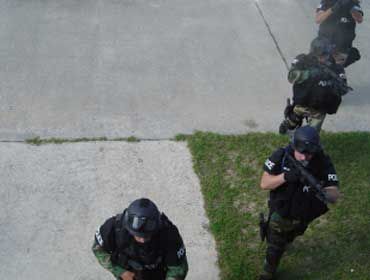Tactical teams all have their own uniqueness about them, but all tend to utilize similar tactics. The first thing we have when being deployed is the approach to where our target is. When “assaulting” buildings most tactical teams seem to favor the simple “stack” approach. I am throwing out another idea for teams to consider. I have used this technique with the military and hope that you will at least consider trying it out and looking at applications for it.
The technique is the utilization of a “wedge” formation on approach. The first time I was exposed to this was while conducting training with an Army Special Forces (National Guard) unit that was involved in Counter Drug operations. The members were discussing the disadvantages of the “stack” formation on an approach. One of the downsides of this approach is that you lose the ability to cover (on approach) a lot of real estate.
We become limited by means of the formation being in a single file and operators only being able to cover the approach from alternating sides. The angles of fire become wide and the stack becomes “easy pickings” for any trained and ready adversary. Going back to basic military tactics, we have essentially made it easier for a “bad guy” to pick off operators in the stack. One semi-auto, military style rifle in the hands of a trained user can cause a lot of damage in a short time. On your approach only half of the operators may be facing that side of the threat. The only ones able to lay down fire are the lead operator or two, then the rest have to move and reposition to return fire or cover other sectors.
As the stack approaches we can see that they are a nice, neat little file. Of course this photo is for illustration purposes, so don’t pick it apart too much! There is quite a bit of control of the movement in this manner and we all know where each other is. An advantage is the team is together at the entrance and can just flow forward. From behind you can see that you do lose opportunity to “get in the fight” if you have to. As bad guys prepare more often for us with weapons and tactics, we need to be able to support one another if things go badly.
This photo is taken from the back of a single stack approach. At the door or front of the building we have a “fight for gun space” as operators worry about lasering each other and covering “open” area. The flow into the building is very controlled and does not require any thinking and little training as no one has to worry about position.
In using the wedge style approach, we have the ability to cover greater sectors of fire. This technique may be suitable for an active shooter approach or an approach where someone is armed and you do not know where the bad guy (or gal) is holed up.
Your team leader assumes a command position behind the point of the “V”, in the center of the formation. This position is behind your breacher, which provides control over the breacher and protection for him. The flanking operators have much wider fields of fire and all have an opportunity to “put guns on target”. You can also designate a “high and low” shooter on the approach. A very effective means for covering a multi-story dwelling.
The ability to cover multiple points cannot be discounted. The team still has integrity while moving and is still in a controlled formation. Once the breach is completed then we can flow into the building. Of course, this is where the training comes in and a method to the madness has to be decided. In this training we tried several variations; alternating every other operator, one side then the other and whatever we thought the situation would dictate. It all flowed fairly smoothly, but with more repetitions it became seamless. As a note and before you start sending me hate mail, I personally think that both techniques have merit and application. This is where I believe that the leadership has to think outside of the box and break away from a mentality of “we have always done….”. The military changes tactics and training to meet their threats and so should we.

This is a photo of the “wedge” approaching the breaching point. The other side of the wedge has fanned out similarly to their side. The wedge can go wide or narrow depending on your terrain and other factors. For those with military backgrounds, especially Infantry, you can get a picture of the formations widening or narrowing as they move on a patrol, depending on the terrain they move through. Similar concept is utilized here. The premise is being able to cover as much open area as we can if a threat presents itself.
I do see the possibilities of this technique and think it would be remiss of any trainer or leader to discount it. We are the ones that are looked on by the agency to look at the options in worst case scenarios. There may be one or two situations where you look back and say to yourself, “I could have used a different approach” and this may have been it.




